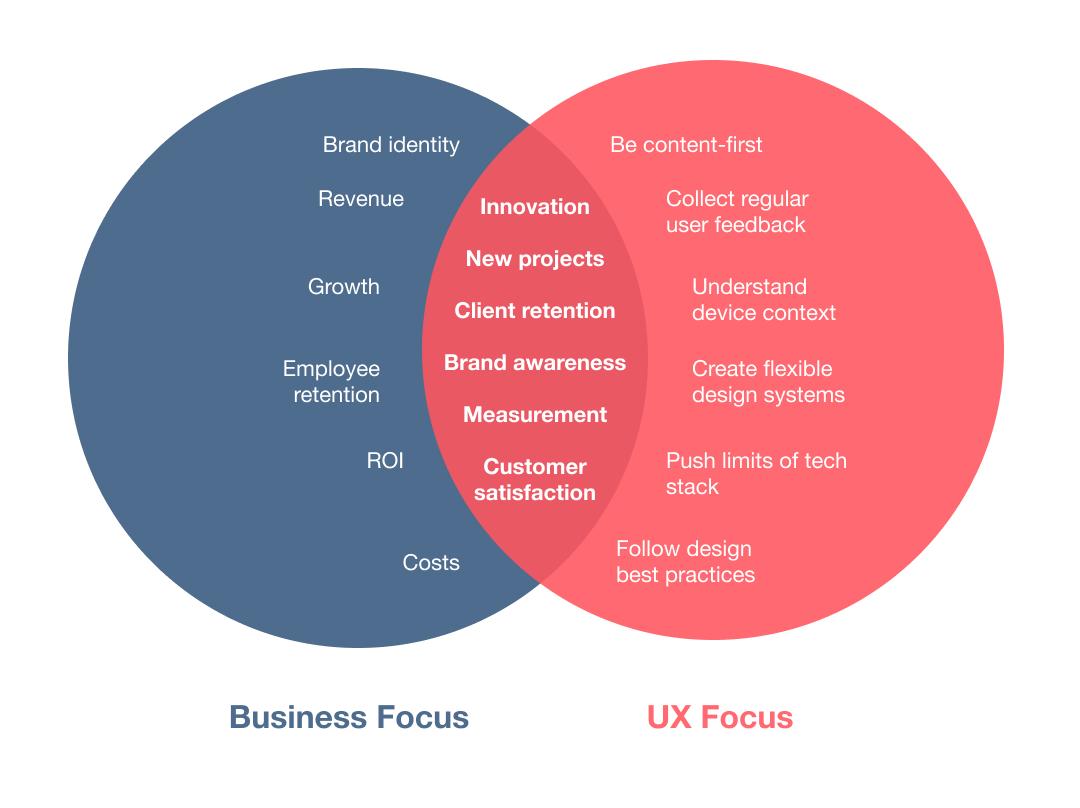
Balancing User Experience and Business Goals
Success is a shared story when every pixel counts and strategy matters.


In product management, teams frequently grapple with the reality of harmonizing user experience (UX) with business objectives. If the focus is only on business objectives, you run the risk of creating an experience that feels out of touch or unempathetic. A product that only prioritizes user experience in a vacuum without considering realistic business goals can lead to wasted resources and missed opportunities for growth.
Striking the right balance between UX and business objectives is therefore a critical strategic challenge. It requires a deep understanding of the user's needs and behaviors, as well as a clear vision of the business's goals and constraints. It also requires the ability to make informed decisions that can satisfy both sides of the equation, often under conditions of uncertainty and change.
As a leading firm specializing in product and customer experiences, we regularly help companies not only manage the delicate balance between user experience and business objectives but create an ecosystem where user experience and business goals mutually reinforce each other. This strategic perspective enables organizations to develop products that win in the market.
Let’s delve deeper into the intersection of UX design and business objectives and the critical steps Rightpoint takes to align them effectively.
The Intersection of UX Design and Business Objectives
In essence, UX design and business objectives are two sides of the same Total Experience coin, each influencing and enhancing the other. If UX design is about creating meaningful and relevant experiences to users, your business objectives represent the most important organizational goals to be fulfilled by your products or services.
Users today have high expectations of those products and services to deliver on their needs, and a poor user experience can lead to user dissatisfaction, reduced engagement, and, ultimately, lower customer retention. Longer-term, negative experiences documented through social media, or ratings & reviews will directly affect brand affinity, putting your larger brand story at risk.
Often, it’s the near-term cost reduction-oriented objectives which lead to an inadvertent compromise on the quality of user experience which affects adoption and retention. Understanding the value of experience and factoring that into short-term cost savings initiatives is a critical step that’s often missed.
A well-designed user experience can lead to increased user retention, loyalty, and conversion. When this leads to the growth of your audience and brand affinity, new business goals will naturally take shape. These in turn should influence the UX design objectives, ensuring the product exceeds the evolving user needs and aligns with the strategic direction of the business.

7 Steps to Align UX Design and Business Objectives
So where do you start? Rightpoint’s proven methodologies are always tailored to meet your organization’s unique needs - both the ones you’re aware of, and the ones we’ll discover with you in our research, design, and implementation phases.
Content, Content, Content
The content you create for your brand will take more forms than you could possibly imagine, both externally to the world, and internally to your employees. A crucial step upon which Rightpoint focuses with every client is an honest, and careful review of your current content landscape. Is your brand story consistent? Is it resonating with your customers and helping them accomplish their goals? Do you know what their goals are? Every business objective and step in a roadmap is made manifest by the content you have today, and the content you need tomorrow. Rightpoint can facilitate these conversations both internally and externally with efficiency and empathy to get to heart of what your users are searching for and what will aid in retention for an engaging user experience. The next few recommendations all stem from gaining a foundational understanding of your content.
Invest in User-Centered Research from the Start
Investing in speaking with your stakeholders and customers is like compound growth – the earlier you start, the smarter you’ll be. After discussing objectives with key stakeholders, we speak with as many members of your audience as possible, as well as employees whose job experience might be impacted by product changes. By hearing straight from the source where your current objectives are aligning and resonating (or not) with their objectives and goals, you’ll have the groundwork for a new roadmap of digital experience and operational enhancements. As that roadmap takes shape, reasonable yet ambitious new business objectives will become clearer.
Embrace Component-Based Design
After gaining an understanding of your content, your users, and how content can support your new business objectives, the design system through which that content is presented to the world is the secret sauce for success. Component-based design means designing your digital experiences with consistent, scalable, flexible elements (components) which can display your content beautifully across all devices and screen sizes via a content management system (CMS - e.g., Optimizely, Sitecore, AEM, etc.). We often use Figma or Sketch in direct collaboration with our clients to get the best output efficiently and quickly, often integrating daily with a client’s design teams. The output of this collaboration is an accessible, branded design system which grows with your business in a device-agnostic, future-proof manner.
Adopt Front-End Code Frameworks
The strategic adoption of front-end code frameworks can significantly expedite the process of building and iterating on a product. These frameworks, such as React, Angular, and Vue.js, provide a structured and standardized way to develop web applications, and countless techniques to drastically reduce development time and effort.
Many front-end frameworks are optimized for performance, and regular updates ensure your web application stays in line with current web standards and the latest developments in web technology.
We can help you choose the right front-end framework based on your project’s specific needs and constraints, the complexity of the app, the expertise of your development team, and your long-term development goals. By adopting a front-end code framework, businesses can streamline their development process, meet their timing, and budget goals, and deliver a high-quality user experience.
Leverage AI and Automation
Once you have the foundation of a strong content strategy which resonates with your audience, presented by a clean component-based design system leveraging front-end code frameworks, now you can really cook with AI & automation.
Building on the foundation of your content, the use of AI in platforms like Adobe Sensei enhances creative expression, accelerates workflows, and provides deep insights, enabling the creation of personalized user experiences at scale. Microsoft Azure AI offers a suite of services that can be tailored to analyze user behavior, provide real-time insights, and deliver content that's relevant to individual users. Through our long-standing partnerships with Adobe and Microsoft, we’ve seen firsthand how these tools and more can significantly reduce the time and cost associated with manual personalization efforts.
By delivering tailored, relevant content and recommendations based on user behavior and preferences, AI not only enhances user engagement and satisfaction but also provides actionable insights. These insights, derived from AI-powered analytics tools, can reveal patterns and trends that inform design decisions, ensuring that the user experience is always aligned with evolving needs and preferences.
AI can also automate and enhance A/B testing, helping to identify the most effective design elements more quickly and accurately. AI-powered chatbots and virtual assistants can provide instant support and guidance, addressing common concerns or questions.
Accessibility in design can be improved with AI-powered tools that automatically generate alt text for images, making content more accessible to users with visual impairments. Predictive design elements, such as predictive typing or auto-complete features, can enhance the user experience by making interactions more efficient.
Through smart integration of AI and automation, businesses can find areas of efficiency for common UX, analytics, or research tasks so the team can spend their time and resources on the bigger challenges.
Embedded Collaboration
Now, all that’s great, but none of the above is possible without embedded collaboration. From day one, we ensure every capability’s perspective - design, data, strategy, content, engineering, and business – has a seat at the table with the client to facilitate comprehensive problem-solving. We establish roles & responsibilities where ownership by leaders is crystal clear and opportunities for every team member to shine are regularly offered. Designers collaborating with engineers from the start ensures technical feasibility, while collaborating with business stakeholders keeps revenue goals aligned. This diversity of thought also promotes more innovative solutions that meet both user needs and business objectives.
Regular collaborative work sessions enable continuous alignment and feedback. Agile frameworks emphasize cross-functional collaboration from the onset versus work passing between silos. We ensure agreement as a team, including the client, as to when it’s convenient to communicate and by what means, and when team members need uninterrupted time to get the work done.
Easy-to-use digital tools, like Miro, help the team with quick, asynchronous communications, leadership buy-in across capabilities, and opportunities for rich knowledge sharing. When combined with regular client dialogue and participation, both the needs of the user and the business are constantly considered.
Measure and Iterate
As the work is nearing completion, it’s critical to ask – “what’s next? How do we keep pushing further?” To measure the success of your product against your business objectives and user satisfaction, we establish measurement plans for collecting and analyzing data on user behavior, product usage, and business performance. Then it gets really exciting, because measurement is just the first step.
Next is to test the product with real users, learn from their feedback, and iterate on the design based on new solutions inspired by what you heard. By continuously testing, learning, and iterating, you can ensure a product that not only meets but exceeds both user and business expectations as your product evolves.
Return on Total Experience (ROTX)
What makes working with Rightpoint so effective is our unique approach to proving the “Return on Total Experience.” In most organizations, the value of an experience is measured as the direct effect on a single or limited set of outcomes. Even worse this doesn’t take into account internal organizational effects. In response we have created what we call Return on Total Experience that defines value of experiences investments across not just an organization’s CX but through its employee experiences as well.
As your improved product user experience increases conversion, where can you invest in your customer support staff, so they aren’t burdened by high turnover? When your loyalty programs see immediate success, where can product design enhancements make the in-store experience a breeze? By establishing thoughtful measurement plans with ambitious KPIs across all three areas, the complete picture of your business – the return on total experience – will take shape. As you surpass each KPI, the most important measurement, proves that the investment in total experience establishes a new foundation for exceeding user goals and business objectives with ease.
Conclusion
As the saying goes, “nothing ventured, nothing gained.” When you invest in validating current and new business objectives to exceed user expectations by helping them accomplish their goals, it reaps unfathomable benefits and rewards for your business and brand.
At Rightpoint, our proven approach leads to product success and a win-win situation for both the users and the business. As your strategic partner, Rightpoint is committed to helping you navigate this balance, driving product success and business growth.


